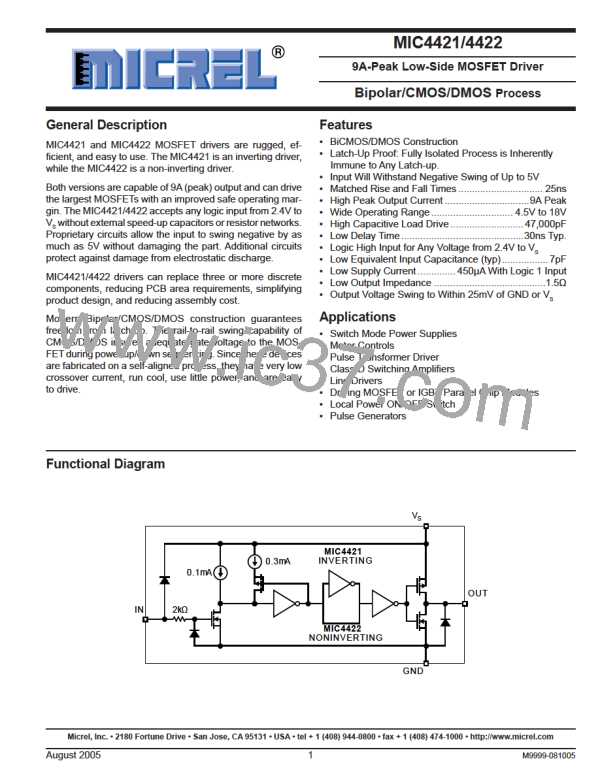MIC4421/4422
Micrel, Inc.
Capacitive Load Power Dissipation
Transition Power Dissipation
Dissipation caused by a capacitive load is simply the energy
placed in, or removed from, the load capacitance by the
driver. The energy stored in a capacitor is described by the
equation:
Transition power is dissipated in the driver each time its
output changes state, because during the transition, for a
very brief interval, both the N- and P-channel MOSFETs in
the output totem-pole are ON simultaneously, and a current
is conducted through them from VS to ground. The transition
power dissipation is approximately:
E = 1/2 C V2
Asthisenergyislostinthedrivereachtimetheloadischarged
or discharged, for power dissipation calculations the 1/2 is
removed. This equation also shows that it is good practice
not to place more voltage in the capacitor than is necessary,
as dissipation increases as the square of the voltage applied
to the capacitor. For a driver with a capacitive load:
PT = 2 f VS (A•s)
where (A•s) is a time-current factor derived from the typical
characteristic curve “Crossover Energy vs. Supply Volt-
age.”
Total power (PD) then, as previously described is just
PD = PL + PQ + PT
PL = f C (VS)2
where:
Definitions
f = Operating Frequency
C = Load Capacitance
VS =Driver Supply Voltage
CL = Load Capacitance in Farads.
D = Duty Cycle expressed as the fraction of time the
input to the driver is high.
Inductive Load Power Dissipation
f = Operating Frequency of the driver in Hertz
For inductive loads the situation is more complicated. For
the part of the cycle in which the driver is actively forcing
current into the inductor, the situation is the same as it is in
the resistive case:
IH = Power supply current drawn by a driver when both
inputs are high and neither output is loaded.
IL = Power supply current drawn by a driver when both
inputs are low and neither output is loaded.
PL1 = I2 RO D
However, in this instance the R required may be either
the on resistance of the driver whOen its output is in the high
state, or its on resistance when the driver is in the low state,
depending on how the inductor is connected, and this is still
only half the story. For the part of the cycle when the induc-
tor is forcing current through the driver, dissipation is best
described as
ID = Output current from a driver in Amps.
PD = Total power dissipated in a driver in Watts.
PL = Power dissipated in the driver due to the driver’s
load in Watts.
PQ = Power dissipated in a quiescent driver in Watts.
PL2 = I VD (1 – D)
PT = Power dissipated in a driver when the output
changes states (“shoot-through current”) in Watts.
NOTE: The “shoot-through” current from a dual
transition (once up, once down) for both drivers is
stated in Figure 7 in ampere-nanoseconds. This
figure must be multiplied by the number of repeti-
tions per second (frequency) to find Watts.
where V is the forward drop of the clamp diode in the driver
(generalDly around 0.7V). The two parts of the load dissipation
must be summed in to produce PL
PL = PL1 + PL2
Quiescent Power Dissipation
RO = Output resistance of a driver in Ohms.
VS = Power supply voltage to the IC in Volts.
Quiescent power dissipation (P , as described in the input
section) depends on whether thQe input is high or low. A low
input will result in a maximum current drain (per driver) of
≤0.2mA; a logic high will result in a current drain of ≤ 3.0mA.
Quiescent power can therefore be found from:
PQ = VS [D IH + (1 – D) IL]
where:
I = quiescent current with input high
IHL = quiescent current with input low
D = fraction of time input is high (duty cycle)
VS = power supply voltage
August 2005
9
M9999-081005

 MIC [ MIC GROUP RECTIFIERS ]
MIC [ MIC GROUP RECTIFIERS ]